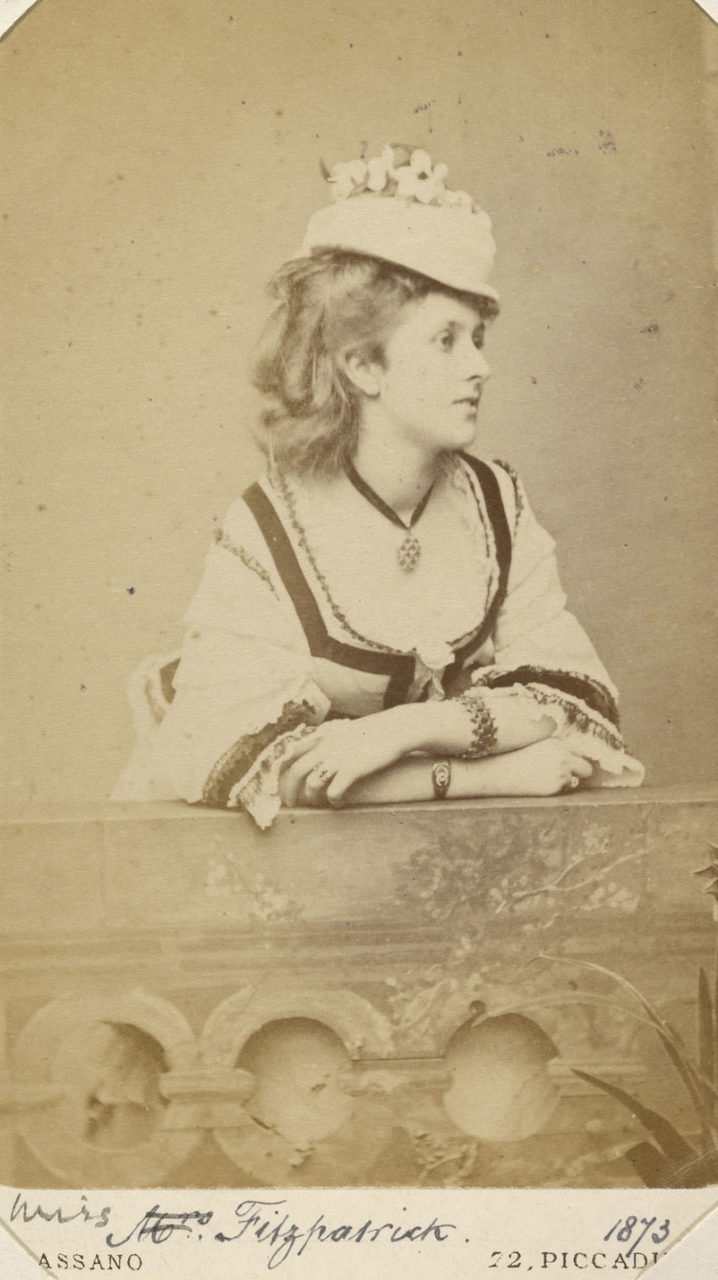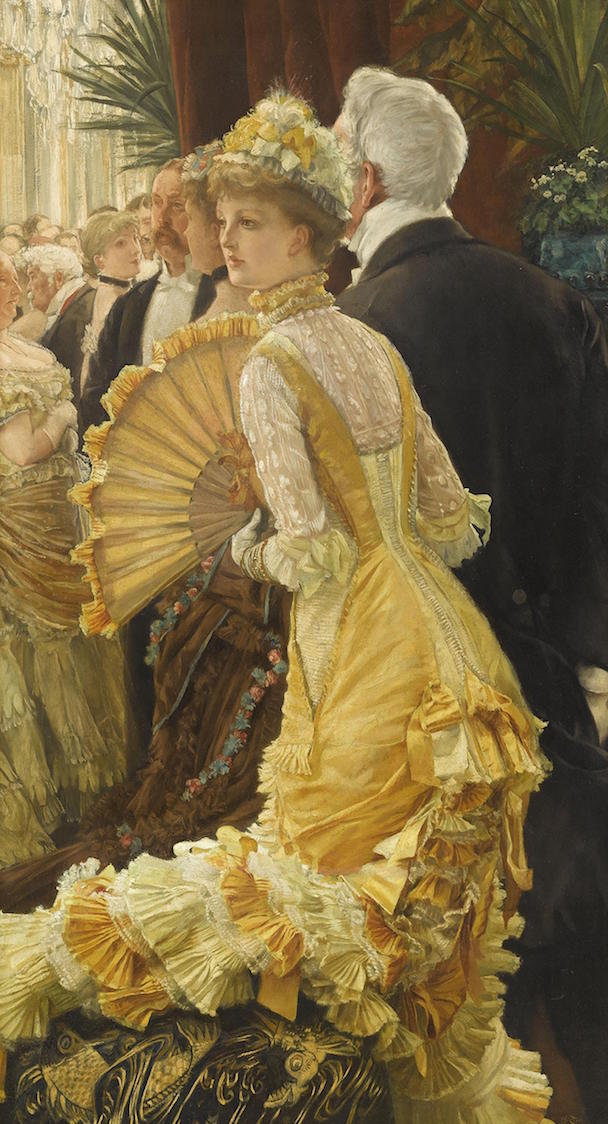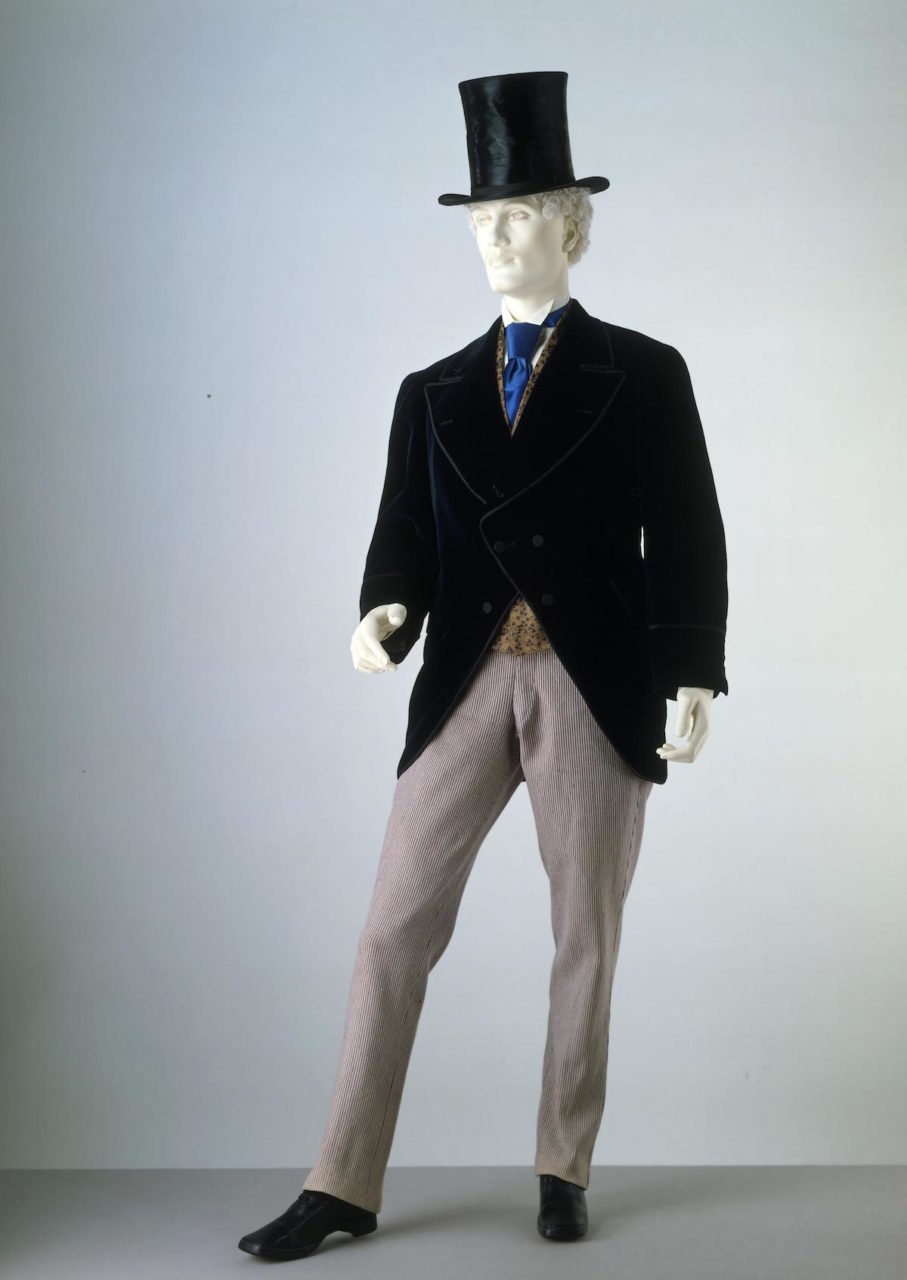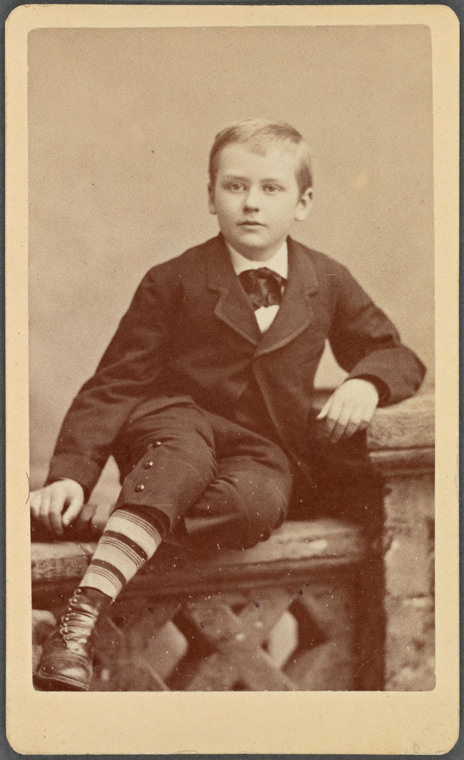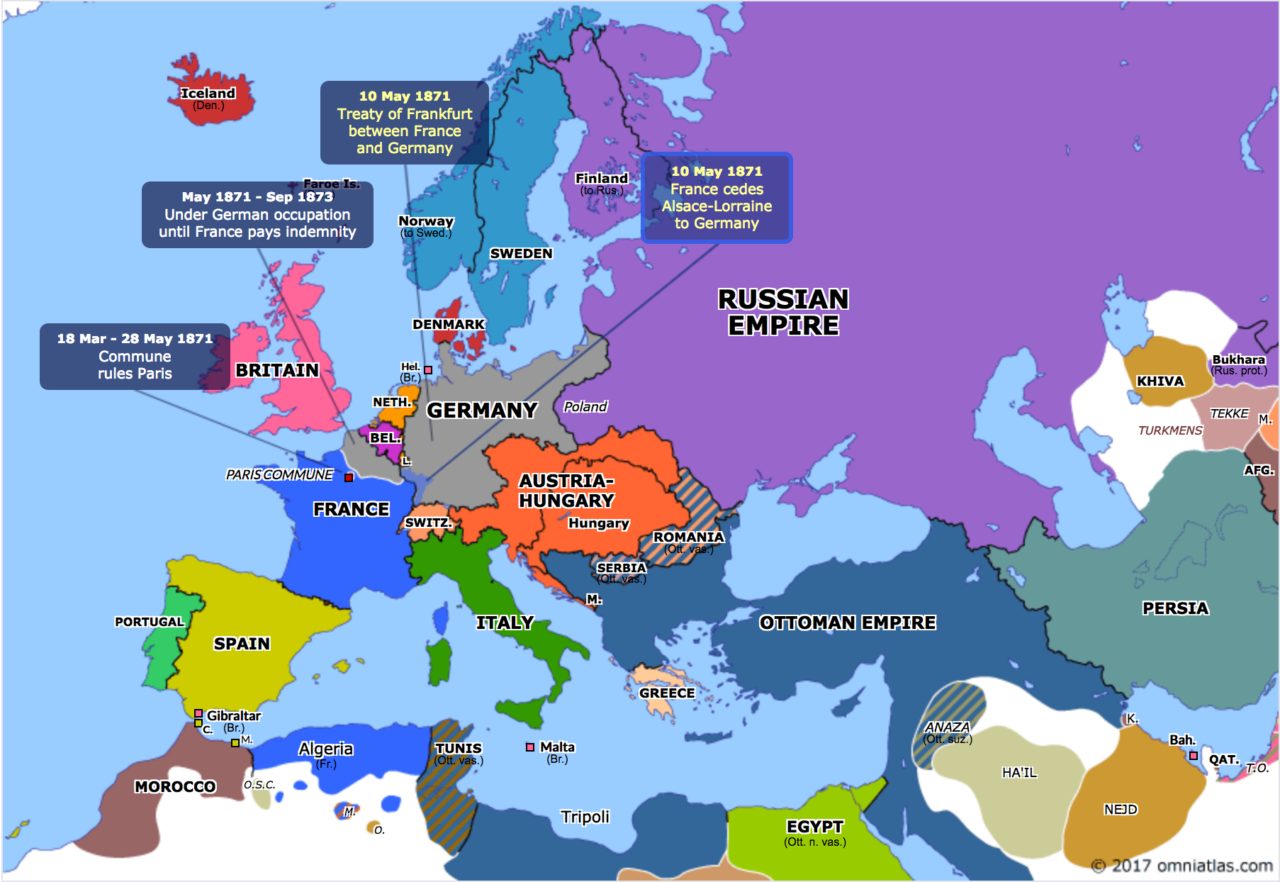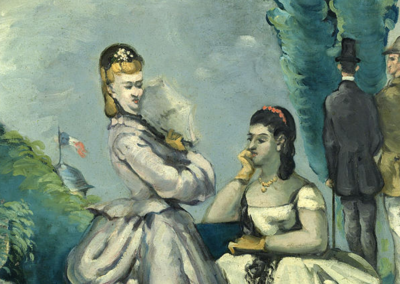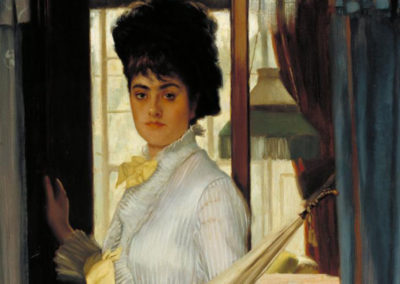OVERVIEW
During the 1870s, women’s clothing became increasingly complex, colorful, and restrictive, while menswear was marked by an industrious sobriety.
Womenswear
During the late 1860s, the volume of the skirt had begun to swing backwards, a departure from the circular skirts of the mid-century. This trend became fully realized in the 1870s, with the focus of clothing concentrated at the back, as skirts projected backwards and fell flat against the body in the front. The decade saw two distinct silhouettes in womenswear, both maintaining the focus on the back of the skirt.
The first silhouette of the decade began in 1870; the great, circular or oval crinolines of previous decades collapsed into the so-called first bustle style (Fig. 1). The bustle was a softly draped protrusion at the back of the waist, created by a manipulation of fabric and drapery (Tortora 386). This sloped bustle style was supported by horsehair-ruffled petticoats or crinolettes, an adaption of the earlier steel crinolines (Fig. 2). A crinolette consisted of rows of fabric-covered steel half-hoops (Cumming 35; Shrimpton 17-18). Bustled dresses of this period were frothy confections, with layers of ruffles, pleats, and gathers. Many featured looped overskirts or long bodices that were draped up over the hips; these were often referred to as “polonaise” style dresses (C.W. Cunnington 261). Fashion historian James Laver quoted a contemporary writer who declared in 1876:
“it is now impossible to describe dresses with exactitude: the skirts are draped so mysteriously, the arrangements of trimmings is usually so one-sided and the fastenings are so curiously contrived that if I study any particular toilette for even a quarter of an hour the task of writing down how it is all made remains hopeless.” (190)
The silhouette of the first half of the 1870s was also defined by a higher than natural waistline and lower sloped shoulders. Bodices frequently featured basques, a kind of peplum extending past the waistline. Basques combined with the overskirts to create a layered look, and the trim on the basques usually matched that of the overskirts (Fig. 3) (Severa 301, 329). In the first years of the decade, the bell-shaped sleeves of the 1860s continued to be seen (Fig. 4) (C.W. Cunnington 258). Bodices were frequently quite as decorated as the skirts. Daytime bodices had high necklines, as was customary throughout most of the nineteenth century. During the early 1870s though, it became common for day bodices to open at the front into a V-neck or square neckline (Fig. 5). These open necklines were almost always trimmed with ruffles, ribbons, lace, or braid, usually echoing the trim of the skirt. Importantly, these revealing necklines caused a trend for prominent necklaces such as velvet chokers and jet pendants (Shrimpton 18-19).
Fig. 1 - Designer unknown (American). Dinner dress, 1870. Silk. New York: The Metropolitan Museum of Art, 2009.300.631a, b. Gift of the Brooklyn Museum, 2009. Source: The Metropolitan Museum of Art
Fig. 2 - Designer unknown (English). Women's Cage Crinolette Petticoat, 1872-1875. Wool plain weave, cotton plain weave, cotton-braid-covered steel, cotton twill tape, and wool-braid trim. Los Angeles: Los Angeles County Museum of Art, M.2007.211.388. Purchased with funds provided by Suzanne A. Saperstein and Michael and Ellen Michelson. Source: Los Angeles County Museum of Art
Fig. 3 - Photographer unknown (American?). Young African American woman, standing with one arm resting on a table, ca. 1870-1875. Photographic print, tintype. Washington, D.C.: Library of Congress, PR 13 CN 1999:022, no. 5 [P&P]. Source: Library of Congress
Fig. 4 - William Powell Frith (English, 1819-1909). The Fair Toxophilites, 1872. Oil on canvas; (38.6 x 32.1 in). Exeter, U.K.: Royal Albert Memorial Museum. Source: Wikimedia
Fig. 5 - Alexander Bassano (English, 1829-1913). Mary 'Patsy' Cornwallis-West, 1873. Albumen print; 8.9 x 5.4 cm. London: Royal Collection Trust, RCIN 2911730. Source: Royal Collection Trust
Fig. 6 - James Tissot (French, 1836-1902). Evening, 1878. Oil on canvas; 91 x 51 cm. Paris: Musee D'Orsay, RF 2253. Source: Wikimedia
Fig. 7 - Designer unknown (possibly Italian). Two-Piece Walking dress, 1878-1880. Wool, silk. Florence: Costume Gallery of Palazzo Pitti. Source: Europeana Collections
Fig. 8 - Photographer unknown (American?). Full length portrait; young lady standing by chair, white neck piece, ca. 1876-1880. Photographic tintype. New Haven, CN: Yale University: Beinecke Rare Book & Manuscript Library, 2002144. From the Randolph Linsly Simpson African-American Collection. Source: Beinecke Rare Book & Manuscript Library
The second silhouette of the 1870s began around 1876 (Laver 196). The bustle collapsed into the the “princess line” style (Fig. 6). Named for Alexandra, Princess of Wales, who popularized the look, it consisted of a dress without a horizontal waist seam, fitted instead with long, vertical tucks and darts to create an extremely slim, body-conscious look (Fukai 126, 214). Similarly, the princess line was echoed in the cuirass bodice (Fig. 7); it did not have a waistline seam and was lengthened to fit over the hips (Cumming 61; Tortora 386). Snug around the hips, princess line dresses and cuirass bodices lacked a bustle, with volume instead spilling from below the hips, and sometimes from below the knees (Fig. 8). This fullness could extend into long trains, even on day dresses (C.W. Cunnington 256).
The waistline dropped to the natural waist in princess line looks. Additionally, shoulder seams began to creep slowly upwards, and sleeves tightened, further accentuating the long, slim line. This newly figure-framing style required more severe corsetry (Fig. 9). Corsets lengthened over the hips to secure the body into the fashionable slim princess silhouette (P. Cunnington 179). The new process of steam-molding created corsets that fiercely formed the female body (Shrimpton 20). Additionally, the tightly fitted gowns required less bulky undergarments, and ladies began wearing combinations, a single garment that connected the chemise and drawers. While combinations had been available as early as the late 1850s, they only became commonly chosen in the 1870s (Tortora 386).
Throughout the decade, dresses generally followed the nineteenth-century customs delineating morning, afternoon, and evening wear. The chief differences were in the cut of the neckline and the length of sleeves (Font 26-28). Note the evening gowns in Beraud’s Une soirée (Fig. 5 in the Menswear section below). It was not uncommon to have two bodices for each skirt, a day and an evening option (Coleman 45; Tortora 390). Outerwear changed during this period from earlier decades. Previously, shawls and capes had been the most fashionable, but the new bustle styles were better served by coats and jackets (Fig. 10). Some even borrowed from menswear styles; both the chesterfield, with its signature velvet collar, and the caped ulster became fashionable choices for women (Cumming 46, 213; Shrimpton 21; Tortora 392).
Fig. 9 - Designer unknown (American?). Corset, 1875-1885. Silk, cotton. Boston: Museum of Fine Arts, 2013.616. Gift of Mary Finnegan. Source: Museum of Fine Arts
Fig. 10 - Artist unknown. The Young Ladies Journal: Latest Parisian Winter Fashions, October 1878. Lithograph. London: Victoria & Albert Museum, E.515-1935. Given by Mrs. W.F.A. Ellison.. Source: Victoria & Albert Museum
Fig. 11 - Designer unknown (American). Day dress, 1870. Silk taffeta and velvet. Boston: Museum of Fine Arts, 64.1003a. Gift of Mrs. Henry P. Kendall. Source: Museum of Fine Arts
The first synthetic dye was invented in 1856, and by the 1870s, vivid, sometimes garish, colors were quite common and fashionable (Fig. 11) (Fukai 212). Bright purples, pinks, blues, and yellows could now be achieved with a vibrancy and permanence that had been impossible with natural dyes of previous eras. Frequently, a dress featured multiple colors, alternating between the bodice and trim, and layered bustle skirts (Fig. 10) (Shrimpton 19). Indeed, fashion historian C. Willett Cunnington wrote, “It is perhaps in their colors that the dresses of the ‘70s are most striking to the eye; the monochrome has vanished” (254). Trims became increasingly heavy as well; dresses were weighed down with flounces, bows, laces, tassels, braid, etc. All of these elements combined to create some of the most complex fashions of the century (C.W. Cunnington 255).
This complexity and restriction led to the introduction of tea gowns in the early 1870s. Meant to be worn at home, perhaps with female friends, these dresses were loose and allowed the wearer to forgivingly loosen their corset, or go without a corset altogether (Fig. 12) (Tortora 387). By the end of the decade, tea gowns could be elaborately trimmed with cascades of lace and frills (Laver 193). Some argue that the princess line developed from tea gowns, as they were usually made without a waist seam (Coleman 47).
Fig. 12 - Designer unknown (American). Tea Gown, 1875-1880. Silk, cotton. New York: The Metropolitan Museum of Art, 2009.300.3856a–c. Gift of the Brooklyn Museum, 2009. Source: The Metropolitan Museum of Art
Fig. 13 - Photographer unknown. Clara Morris, ca. 1878-1880. New York: New York Public Library, *T PHO A. Source: New York Public Library
Throughout the decade, bonnets, defined by the strings tied around the chin (Cumming 26), were seen alongside the ever more fashionable hat, differentiated by its lack of strings. By the 1880s, the bonnet was relegated to Sunday best ensembles and older women (Ginsburg 91). Hairstyles were elaborate during the first half of the 1870s. Women’s hair, usually parted in the center and waved around the face, was piled up in intricate knots and braids with cascades of curls falling down the back; false hair was generally worn (C.W. Cunnington 296). This “waterfall hairstyle” pushed headwear up and forward to perch over the forehead (Figs. 4-5) (Tortora 393). These precariously tipped hats and bonnets were frequently heavily trimmed with falls of flowers and ribbons. The tumbling trim and curls echoed the softly draped bustle (Laver 191). Hairstyles simplified with the introduction of the princess line, and by the end of the decade, hair was worn in high, tight chignons without loose curls. Sometimes, a short curly fringe was cut in the front (Shrimpton 22). With the new, neat hairstyles, hats took on more definite shapes, created out of dense felts and straws (Fig. 13). In her history of millinery, Madeliene Ginsburg noted that “the trimmings were architectural in their clarity of form but naturalistic, horticultural, zoological, and even entomological in content” (92).
Fashion icon: Alexandra, Princess of wales (1844-1925)
Alexandra, Princess of Wales, and later Queen of England, held a uniquely powerful influence over nineteenth century fashion (Fig. 1). Born in 1844 in Denmark, Alexandra wed Queen Victoria’s eldest son, Albert Edward on March 10, 1863. She immediately captured the attention of the public, and quickly became beloved by the British people, a population starved for royal youth and glamour (Strasdin introduction). By the 1870s, Alexandra’s importance in nineteenth-century fashion was such that the “princess line” was named for her (Coleman 48; Fukai 126). Her trim figure was the beauty ideal of the time and was displayed to fantastic effect in this new style, which she did much to popularize it (Fig. 2). She was also associated with the emergence of the preference for tight chignons and curled fringe in the late 1870s (Shrimpton 22). Alexandra even kept up to date with the latest trends in color, never shying away from the newest bright hues (Strasdin ch. 3).
Throughout her life, especially during the 1870s and 1880s when she was at the height of her sartorial powers, Alexandra used opulent and fashionable dress to great effect. In contrast to the aging Queen Victoria, Alexandra kept a busy social calendar, always appearing in the latest mode. While Victoria dressed in British mourning fashion, Alexandra frequently bought and wore Parisian couture. Her modish, youthful style breathed new life into the British monarchy (Strasdin introduction). Fashion historian Kate Strasdin argues that Alexandra’s popularity, supported through her clothing choices, may have had outsized effects on the stability of the monarchy, writing:
“As the epitome of a ‘princess’ her clever clothing choices meant that she was both regal as the event required, or through a general conformity of style she made herself more available as a public figure in a way that Victoria had ceased to be.”
Fig. 1 - W & D Downey. Alexandra, Princess of Wales, with Princess Louise, September 1870. Albumen print; 8.5 x 5.5 cm. London: Royal Collection Trust, RCIN 2902294. Source: Royal Collection Trust
Fig. 2 - Photographer unknown. Princess Alexandra, ca. 1878. Source: Pinterest
Menswear
Fig. 1 - Alexander Bassano (English, 1829-1913). Sir David Baird, 3rd Bt, ca. 1873. Glass negative. London: National Portrait Gallery, NPG x127994. Source: National Portrait Gallery
Fig. 2 - Parlor Gallery (American). Three quarter length portrait of man with mutton chop whiskers, in frock coat leaning on ivy pedestal, 1875. Photographic print on cabinet card; 17 x 11 cm. New Haven, CN: Yale University: Beinecke Rare Book & Manuscript Library, 2002294. From the Randolph Linsly Simpson African-American Collection. Source: Beinecke Rare Book & Manuscript Collection
In 1871, a tailoring trade journal observed, “Gentlemen dress as quietly as it is possible to do and there are no extremes in dress” (Shrimpton 35). Indeed, menswear in the 1870s was marked by sobriety and understated style. The overall silhouette slimmed a bit from the boxy, oversized jackets of the 1860s (Fig. 1). Shirts became plain, no longer pleated and heavily starched, which only underscored the crisp, clean line (Tortora 401). Men cropped their hair shorter than earlier years, and wore it neatly parted. A clean-shaven face was rare; full “muttonchop” whiskers or trim mustaches were the mode (Fig. 2). Fashion historian Jayne Shrimpton wrote:
“the average middle-class businessman carefully avoided exagerrated or effeminate fashions. With a gold watch chain displayed prominently across his waistcoat front, and bushy mutton-chop whiskers or a beard lending an air of authority, the sober-suited Victorian male aimed for a respectable, efficient, industrious image.” (36)
The basic elements of menswear remained generally the same. The frock coat (Figs. 1-2), featuring a waist seam with a full skirt (Cumming 87), was the most formal daywear for business or formal calls in town (Laver 202; Shrimpton 37). In the first half of the decade, there was a trend for very short frock coats, with hemlines well above the knees (Foster 99). A less stuffy choice was the morning coat, a cutaway jacket with a waist seam (Cumming 135). During the 1870s, the morning coat, single or double-breasted, featured three or four buttons, and could be bound with silk braid for an elegant finish (Fig. 3). The morning coat possessed a surprising versatility, becoming formal when tailored in dark cloth paired with grey trousers or stylishly relaxed when made in tweed (Shrimpton 37).
Finally, the sack or lounge suit was increasingly fashionable, particularly among the working classes. The sack jacket, marked by its lack of a waist seam, was often paired with a matching waistcoat and trousers to make a coordinated suit (Fig. 4) (Tortora 401). This suit, most often worn with a plain white shirt featuring a turn-down collar and a four-in-hand tie, arguably formed the foundation for the modern three-piece suit (Shrimpton 37). Evening occasions called for the formal black tailcoat, featuring knee-length tails, a matching double-breasted waistcoat, starched white shirt and bow tie, and black trousers, usually with braid down the outer side seams (Fig. 5) (Tortora 402).
Fig. 3 - Designer unknown. Morning coat, vest and trousers, 1873-1875. Cotton, silk, wool. London: Victoria & Albert Museum, T.3-1982. Source: Victoria & Albert Museum
Fig. 4 - Artist unknown. Gentleman's Magazine Fashion Plate, 1876. London: Victoria & Albert Museum, E.978-1946. Source: Victoria & Albert Museum
Fig. 5 - Jean Béraud (French, 1849-1935). Une soiree, detail, 1878. Oil on canvas; 65 x 117 cm. Paris: Musee D'Orsay, RF 1994 15. Source: Musee D'Orsay
Fig. 6 - Gustave Caillebotte (French, 1848-1894). Paul Hugot, 1878. Oil on canvas. Private Collection. Source: Wikimedia
The chesterfield coat, edged with braid and silk velvet facings, was the most popular form of outerwear, cut knee-length in the 1870s (Fig. 6) (Cumming 46; Tortora 402). The top frock was an outer garment cut along the same lines as the frock coat underneath. Both the Inverness and Ulster coats featured attached capes, sometimes detachable (Laver 205; Tortora 402-403). For sporting, the double-breasted reefer jacket was increasingly worn (Fig. 7) (Laver 202). Regarding headwear, the top hat was the most formal style, worn with frock coats, fancy morning suits, and in the evening. The more democratic bowler hat was fashionable with morning and sack suits (Tortora 403). Accessories and jewelry were simple and elegant, including the four-in-hand necktie, a silk cravat fastened with a stick-pin, and a gold watch chain strung across the waistcoat (Shrimpton 36-38).
Fig. 7 - Thomas Rodger (Scottish, 1832-1883). Prince Leopold, October 1876. Albumen print; 13.8 x 9 cm. London: Royal Collection Trust, RCIN 2903079. Source: Royal Collection Trust
CHILDREN’S WEAR
Fig. 1 - Photographer unknown. Miss Nellie Grant with Baby, 1876. Glass negative. Washington D.C.: Library of Congress, LC-BH826-1429. Source: Library of Congress
In the 1870s, as throughout most of the nineteenth century, boys and girls were almost indistinguishable from one another during infancy and toddlerhood (Olian v). Babies were dressed in white linen or cotton gowns with high necks and long sleeves (Fig. 1), reflecting the burgeoning attitude that newborns required extra warmth. As the child became old enough to walk, they progressed into short dresses usually featuring rows of tucks and smocking (Fig. 2) (Shrimpton 43).
Young girls simply echoed the fashions of adult women, with a shorter hemline that gradually fell to the floor through their adolescence (Olian 25-27). The early 1870s padded bustle effect was seen in girls’ dresses with looped overskirts and large bows, all made in the bright colors and heavy trims that their mothers wore (Fig. 3) (Severa 345; Shrimpton 52). When the princess line came into vogue, girls dresses reflected that trend as well, collapsing into a narrow tube with tight sleeves. Frequently, the slim line was emphasized with a contrasting panel running down the center of the dress or bodice (Fig. 4) (Rose 85). Girls wore their hair long and curled, sometimes with a fringe in the front, similar to the waterfall hairstyle worn by adult women. In the late 1870s, when adult hairstyles became neatly tucked up into chignons, girls began wearing their hair up when they reached young adulthood, around sixteen years old. A young girl’s accessories, from jewelry to millinery, also reflected adult fashions (Olian iv).
Fig. 2 - G Formosa. Children of the Duke and Duchess of Edinburgh: Princess Marie, Princess Victoria, Prince Alfred, March 1878. Albumen print; 14.4 x 9.4 cm. London: Royal Collection Trust, RCIN 2903204. Source: Royal Collection Trust
Fig. 3 - Carolus Duran (French, 1837-1917). Mademoiselle Sabine, 1875. Source: Pinterest
Fig. 4 - Designer unknown. Girl's dress, ca. 1878. Silk. Los Angeles: Los Angeles County Museum of Art, AC1999.46.22. Gift of Helen Larson. Source: Los Angeles County Museum of Art
Fig. 5 - Abraham Bogardus (American, 1822-1908). Unidentified Boy, ca. 1875. Albumen print; (3.75 x 2.25 in). New York: New York Public Library, 92PH020.496. Source: New York Public Library
Around the age of five, boys were “breeched,” a rite of passage in which they are given their first pair of pants. After that, boys wore various suits, often distinguished from adult versions only by the length of the trousers. Boys wore knickerbockers, which buckled or buttoned under the knee. Like adult menswear, boys suits narrowed in the 1870s (Shrimpton 45-47). A common choice was a version of the adult sack suit (Fig. 5) (Olian 29). Alternately, knickerbockers paired with a matching belted jacket was fashionable (Mager 76). As throughout the second half of the nineteenth century, sailor suits were very popular for young boys. An example can be seen in figure 3 in the Menswear section above. Interestingly, the 1870s saw a particular trend for silk plush and velvet fabrics in boys’ clothing (Fig. 6) (Shrimpton 47). In adolescence, boys graduated to long trousers and began to look very much like their fathers (Tortora 405).
Fig. 6 - Designer unknown. Boy's Suit, 1870-1879. Cotton velvet. New York: The Metropolitan Museum of Art, 1976.60.8a–d. Purchase, Irene Lewisohn Bequest, 1976. Source: The Metropolitan Museum of Art
References:
- Coleman, Elizabeth Ann. The Opulent Era: Fashions of Worth, Doucet, and Pingat. London: Thames and Hudson, Ltd., The Brooklyn Museum, 1989. http://www.worldcat.org/oclc/469409564
- Cumming, Valerie ed., The Dictionary of Fashion History. New York: Berg, 2010. http://www.worldcat.org/oclc/1003643284
- Cunnington, C. Willett. English Women’s Clothing in the Nineteenth Century: A Comprehensive Guide with 1,117 Ilustrations. Mineola, New York: Dover Publications, 1990. http://www.worldcat.org/oclc/868281120
- Cunnington, Phillis. The History of Underclothes. London: Michael Joseph, 1951. http://www.worldcat.org/oclc/759766118
- Font, Lourdes M. and Trudie A. Grace. The Gilded Age: High Fashion and Society in the Hudson Highlands, 1865-1914. Cold Spring, NY: Putnam County Historical Society & Foundry School Museum, 2006. http://www.worldcat.org/oclc/77078793
- Foster, Vanda. A Visual History of Costume: The Nineteenth Century. London: BT Batsford, 1984. http://www.worldcat.org/oclc/28405843
- Fukai, Akiko, ed. The Collection of the Kyoto Costume Institute: Fashion, A History from the 18th Century to the 20th Century. Kyoto: Taschen, 2013. http://www.worldcat.org/oclc/81452017
- Ginsburg, Madeliene. The Hat: Trends and Traditions. London: Studio Editions, 1990. http://www.worldcat.org/oclc/22914760
- Laver, James. Costume and Fashion: A Concise History, 5th ed. London: Thames & Hudson, Ltd, 2012. http://www.worldcat.org/oclc/966352776
- Mager, Alison, ed. Children’s Fashions of the Past: In Photographs. New York: Dover Publications,1978. http://www.worldcat.org/oclc/868272961
- Olian, JoAnne, ed. Children’s Fashions 1860-1912. New York: Dover Publications, 1994. http://www.worldcat.org/oclc/28963700
- Rose, Clare. Children’s Clothes: 1750-1985. London: BT Batsford, 1989. http://www.worldcat.org/oclc/317672212
- Severa, Joan L. Dressed for the Photographer: Ordinary Americans and Fashion 1840-1900. Kent, Ohio: Kent State UP, 1995. http://www.worldcat.org/oclc/552147475
- Shrimpton, Jayne. Victorian Fashion. Oxford: Shire Publications, 2016. http://www.worldcat.org/oclc/896980798
- Strasdin, Kate. Inside the Royal Wardrobe: A Dress History of Queen Alexandra. London: Bloomsbury, 2017. http://www.worldcat.org/oclc/1084717619
- Tortora, Phyllis G. and Keith Eubank. Survey of Historic Costume, 5th ed. New York: Fairchild Books, 2010. http://www.worldcat.org/oclc/865480300
Historical Context
Wikipedia: 1870-1879
Rulers:
- America
- President Ulysses S. Grant (1869-77)
- President Rutherford B. Hayes (1877-81)
- England: Queen Victoria (1837-1901)
- France
- Emperor Napoleon III (1852-70)
- Paris Commune (1871)
- Third Republic:
- President Adolphe Thiers (1871-73)
- President Patrice de Mac-Mahon (1873-79)
- President Jules Grévy (1879-87)
- Spain
- Regent Francisco Serrano y Domínguez (1868-71)
- King Amadeo I (1871-73)
- 4 Presidents of Spanish Republic(1873-74)
- King Alfonso XII (1874-85)
Europe, 1871. Source: Omniatlas
Events:
- 1870 – Italy united
- 1870-71 – Prussians besiege Paris
- 1871 – Germany united under the Second Reich
- 1872 – The marcel wave is first developed by hairdresser Francois Marcel, and remains popular for more than 50 years.
- 1873 – First color photos appear
- 1874 – Impressionists hold first group show
- 1875 – Liberty Co department store opens in London.
- 1876 – Bell patents telephone
- 1879 – Edison invents the electric lightbulb
Timeline Entries
Primary/Period Sources
Resources for Fashion History Research
To discover primary/period sources, explore the categories below.
Have a primary source to suggest? Or a newly digitized periodical/book to announce? Contact us!
Fashion Plate Collections (Digitized)
- Costume Institute Fashion Plate collection
- Casey Fashion Plates (LA Public Library) - search for the year that interests you
- New York Public Library:
NYC-Area Special Collections of Fashion Periodicals/Plates
- FIT Special Collections (to make an appointment, click here)
- Costume Institute/Watson Library @ the Met (register here)
- Journal des demoiselles, 1870-79 (AP20 .J76 RARE BOOK)
- La Mode illustrée, 1870-79 (AP21.A3 M6 Q)
- New York Public Library
- Brooklyn Museum Library (email for access)
Womenswear Periodicals (Digitized)
Etiquette Books (Digitized)
Menswear Periodicals / Etiquette Books (Digitized)
Secondary Sources
Also see the 19th-century overview page for more research sources... or browse our Zotero library.






